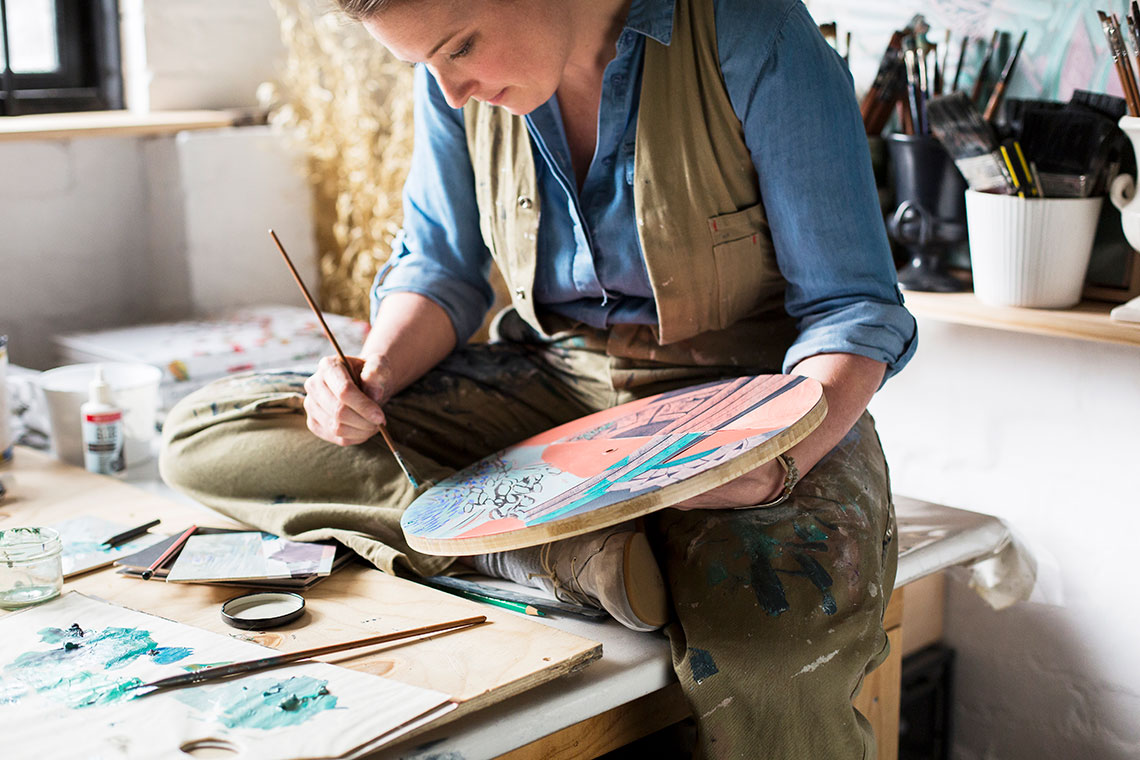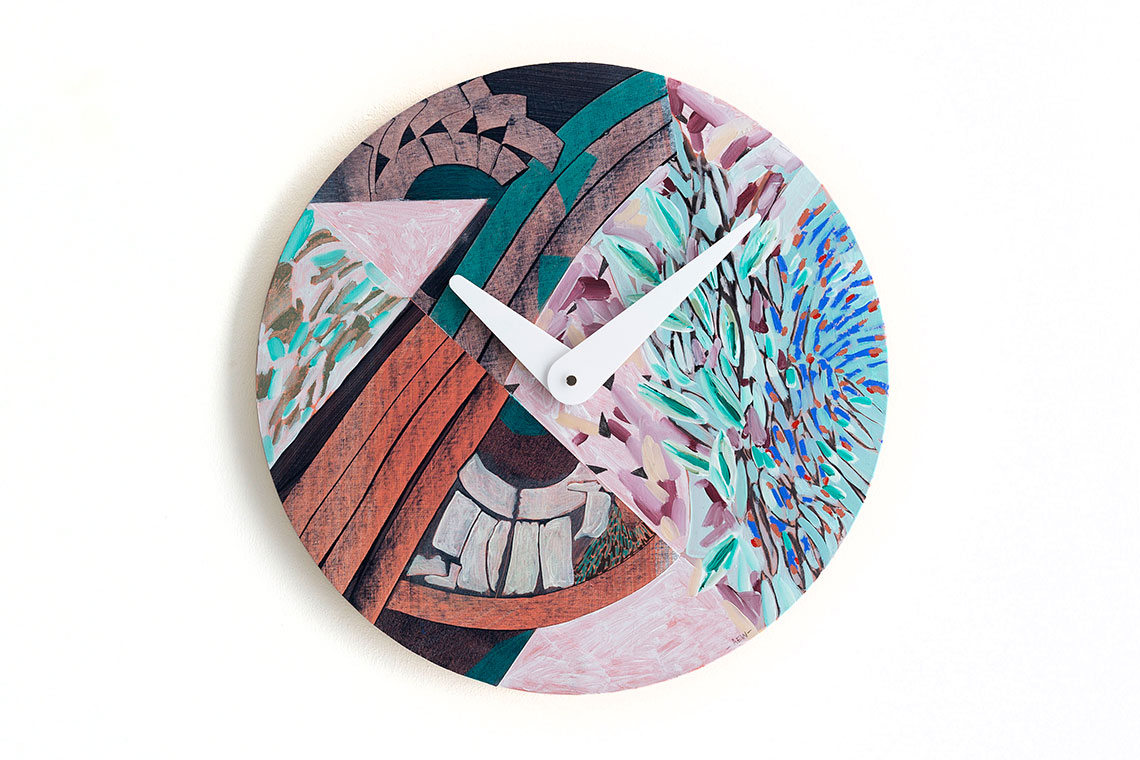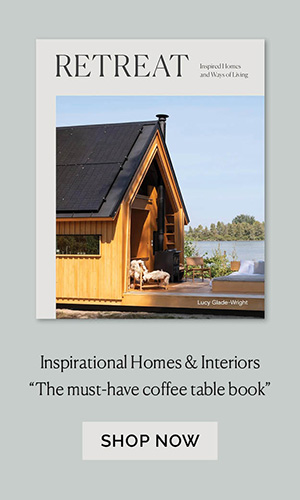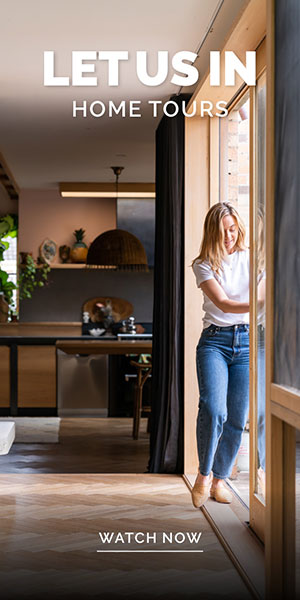Amy Wright is one of those people that seems to have lived her life twice, she is a wealth of knowledge, with a list of extraordinary life stories far longer than most. She has lived abroad, studied with a member of the Bauhaus, founded a career in flowers and again in textiles, worked in sculpture and mastered screen printing, but her focus now lies firmly on her painting and paving a career as an artist.
I seemed to know Amy before I met her. She suddenly popped into my life… mentioned in passing conversation / a friend of a friend / worked with colleague… the list continued. When we finally met I had the strangest feeling of deja vu. She’s familiar in a bold and positive way. Her laugh is loud and contagious and made my cheeks hurt. Her work is thoughtful and delicate. And her attitude, optimistic and cheerful.
Amy’s clock is available via online auction. To bid, click here.
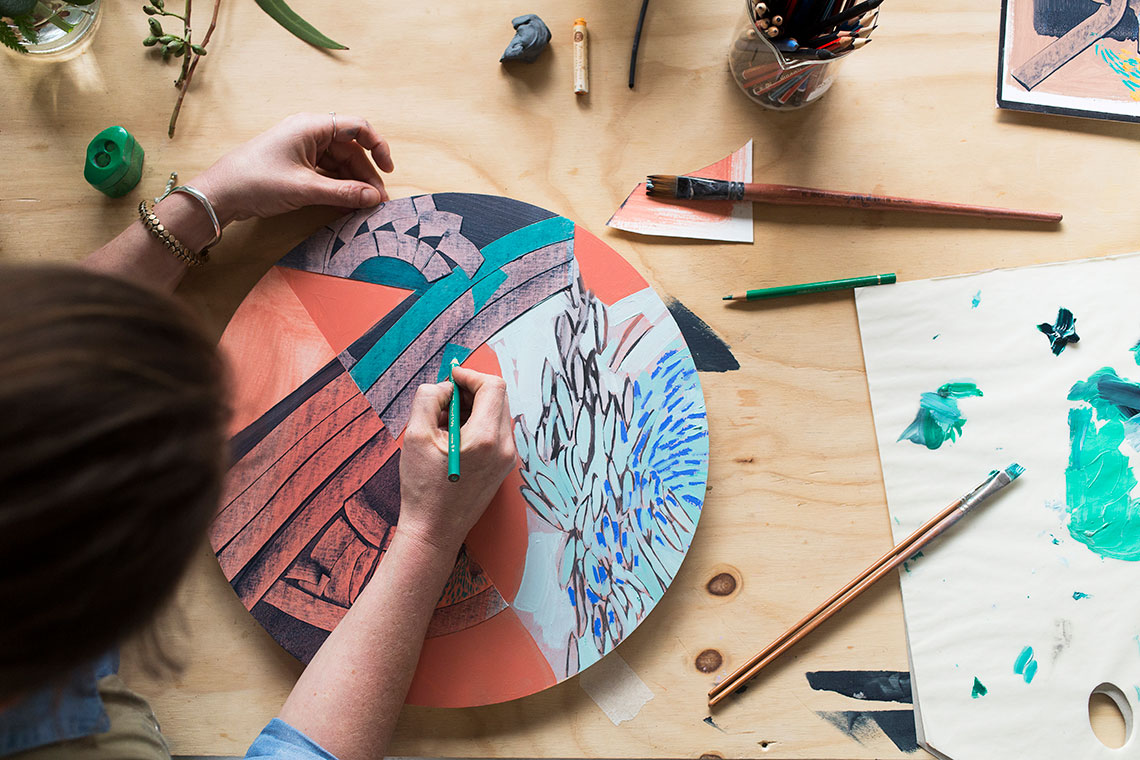
Can you describe the feeling you get when you’re painting?
I guess when I’m painting, it feels – it sounds real daggy – but it feels like you sort of come home. It’s when I feel most like myself. It’s when I’m calmest and when I feel the most inspired. It’s just intrinsic to me, being creative. I can’t separate myself from my painting or my creating.
When did you realise that you were creative?
I first realised I was creative when I wanted a tool belt at the age of about four. My dad’s always been very, very, creative and he was always making things. I never wanted to be the girl wearing the pretty dresses and going off and buying stickers of fairies and things like that. It was always remember having the tool belt, making something, building something. I always wanted to paint everything when I finished it. Big cubby houses that had multiple floors, all had curtains, every wall was painted a different colour. I always just knew that I’d be doing something a little quirky and creative.
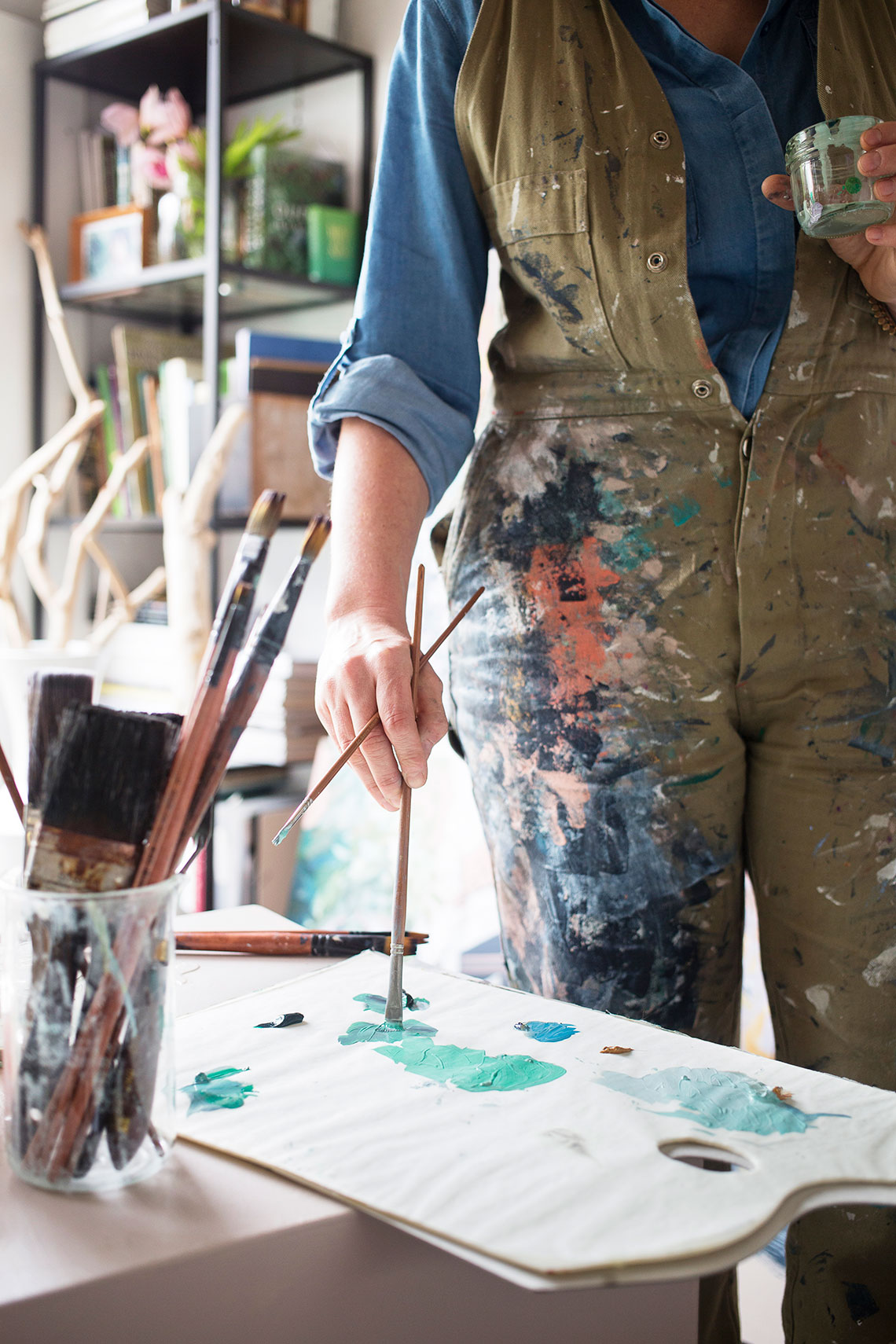
Where do you draw inspiration?
I draw inspiration mainly from the botanical world. I’ve always been fascinated by flowers. My grandmother was a botanical watercolourist, so I used to do a lot of really detailed watercolour paintings with her. I’ve since moved on from that. I think because of my textile training, I’m much more interested in the textures and the details and the colours that come from plants. It’s always got a botanical bent, everything I do.
You’re a woman of many talents. With all the different mediums you’ve explored and experimented with, what is your favourite medium?
I’ve explored so many different avenues. It’s been a little bit crazy. I started off doing sculpture and working with 3D form, then I moved into textile design, so I was a fabric printer. I used to do a lot of screen printing, so I’d start designing repeat patterns for that. I did my own screen printing and had my own business printing my own fabrics. I’ve moved it back into the painting side of things on canvas and wood. I guess I’ve recently got into painting in oil, which has been a new development.
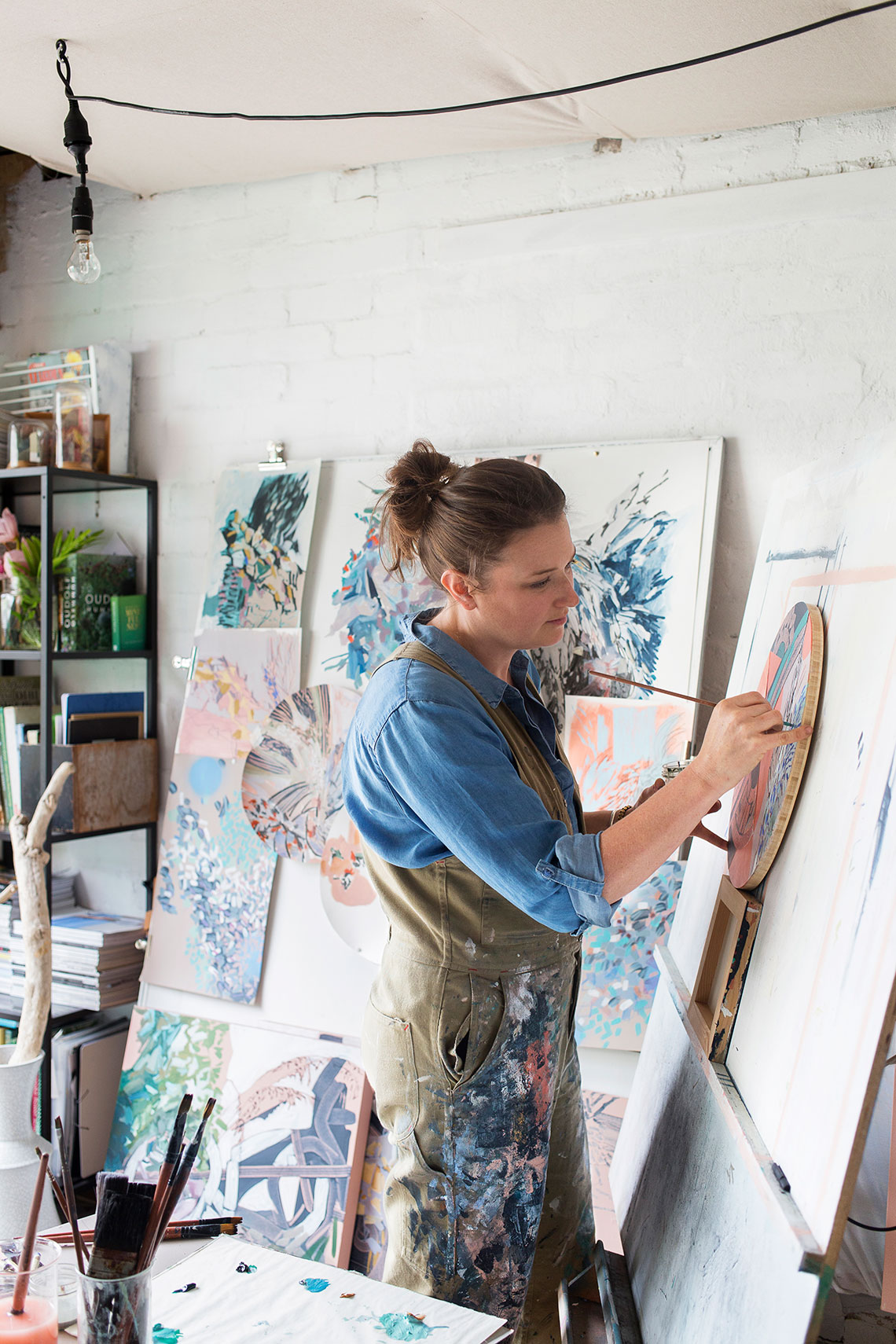
How do you start a new piece?
Generally, I just start. I’ve never been somebody that’s been very good at planning. I have an idea, I have hundreds of ideas in my head. I generally come up with a colour palette to some degree. I just start with a white canvas and just start putting colour on it and just sort of see what happens. It seems to emerge on canvas. The great thing is you can always take anything off and start again. It’s not quite so fearful anymore to paint on that brand new white piece of paper like I used to.
You used to be fearful?
Yeah, with a piece of paper, you’d always think any mark you put on it you can’t take it off. It was always a bit like, “This is really daunting.” Working with oil, especially, you can just paint over everything or you can remove it and you can build up the layers again. It doesn’t feel quite so permanent when you’re working which is what I really like about it.
Has that changed how you work?
Definitely. I’m much more organic than I used to be in the way that I work. It’s more about layering and often things come out of the layers that I wouldn’t have planned for, different textures and different shapes that emerge which generally just make the piece at the end.
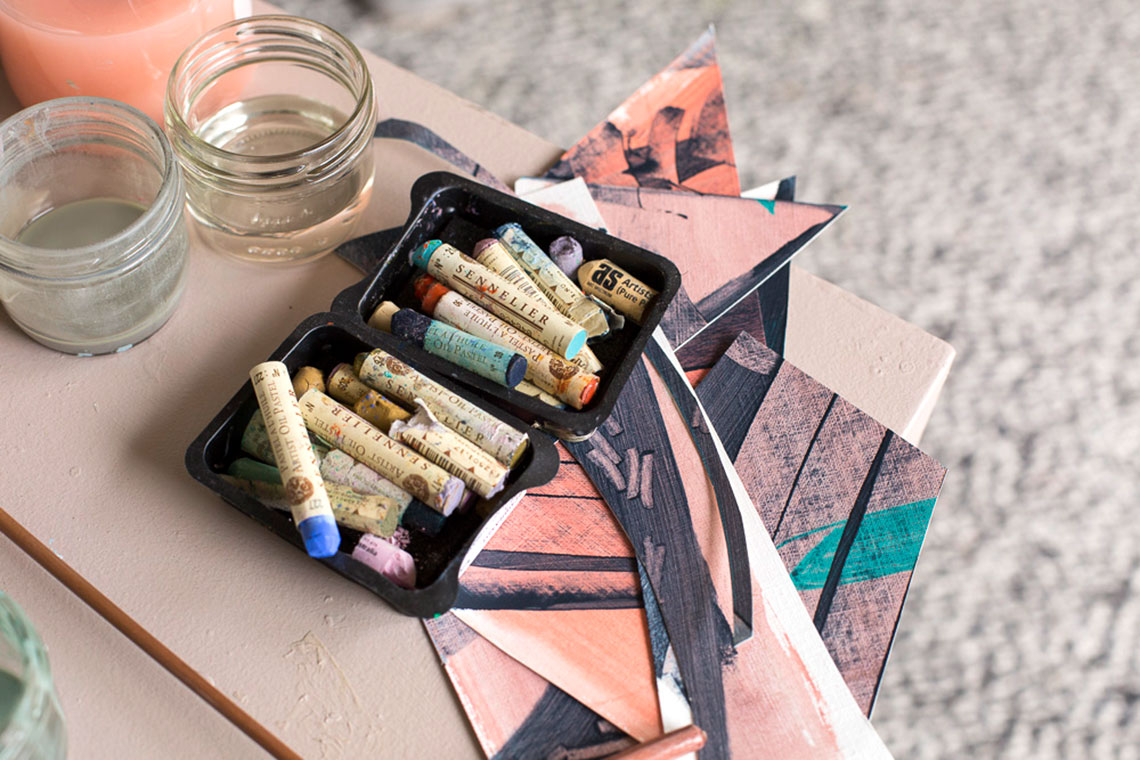
Who or what has been a major influence in your artwork?
I was very lucky as a kid to have private tutoring with a couple of art teachers. One was a guy, Mr. Pugh, who was my old art teacher in England. He was very much about graphics. He was really interested in drawing what was in front of you and creating shape from it. I worked with him for about two years. When I was 15, I had an amazing lady called Yolanda as my tutor. She actually started at the Bauhaus, so she was a very elderly lady. She was the first person that actually made me think about what was on the other side of what I was drawing. All of the sudden, I became really aware of 3D object rather than just painting flat surfaces.
I think it’s really impacted on my work because often I will draw what’s in front of me and then I’ll almost do like a blind drawing imagining – what was on the other side – to try and come up with other textures and patterns.
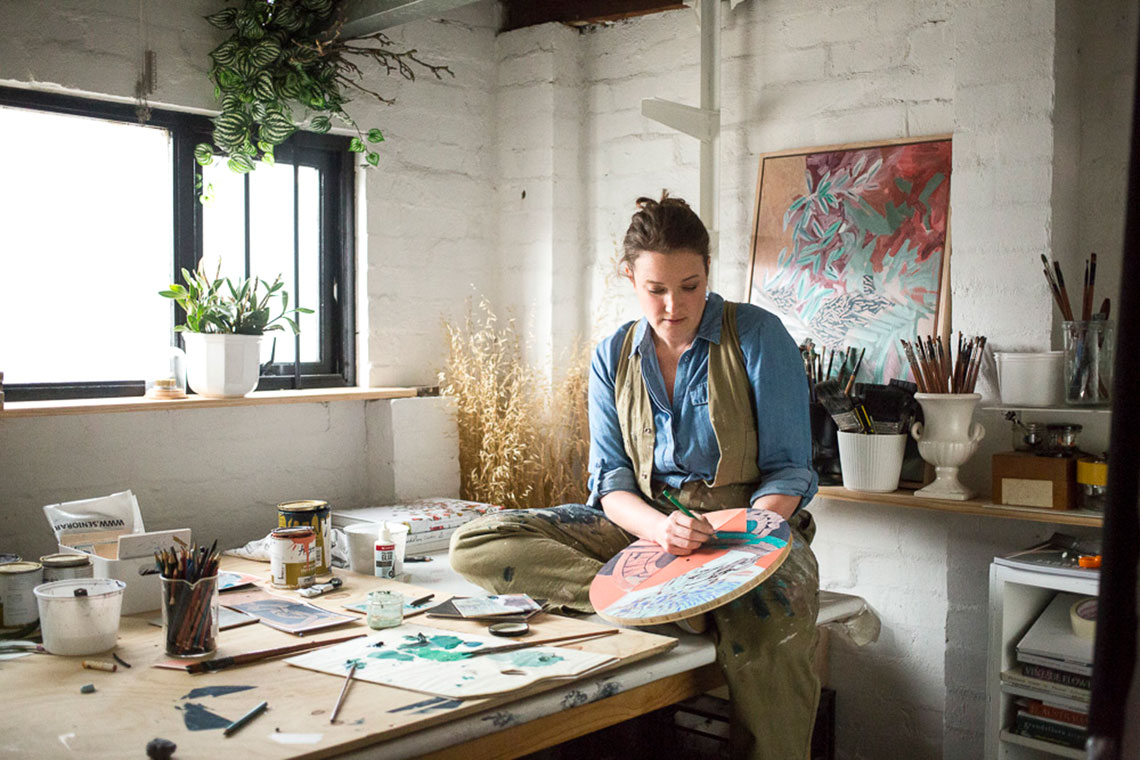
You started painting at quite a young age, but explored many different paths before returning to paint. How has that creative journey influenced your work?
I started off doing painting. Watercolours. Really detailed realistic paintings, botanical illustration style. Then I moved into sculpture, where I was taught to weld and do plaster carving and things like that as well as stone carving. Then I ended up doing textiles and moved through floristry. I have another business where I do wedding flowers. Then I’ve come full circle to do paintings again. That’s where I really want to go. I guess because I’ve got all this experience in different areas, I feel like I can draw aspects of all of them into these big paintings. My paintings keep getting bigger and bigger. They almost feel a bit sculptural in themselves.
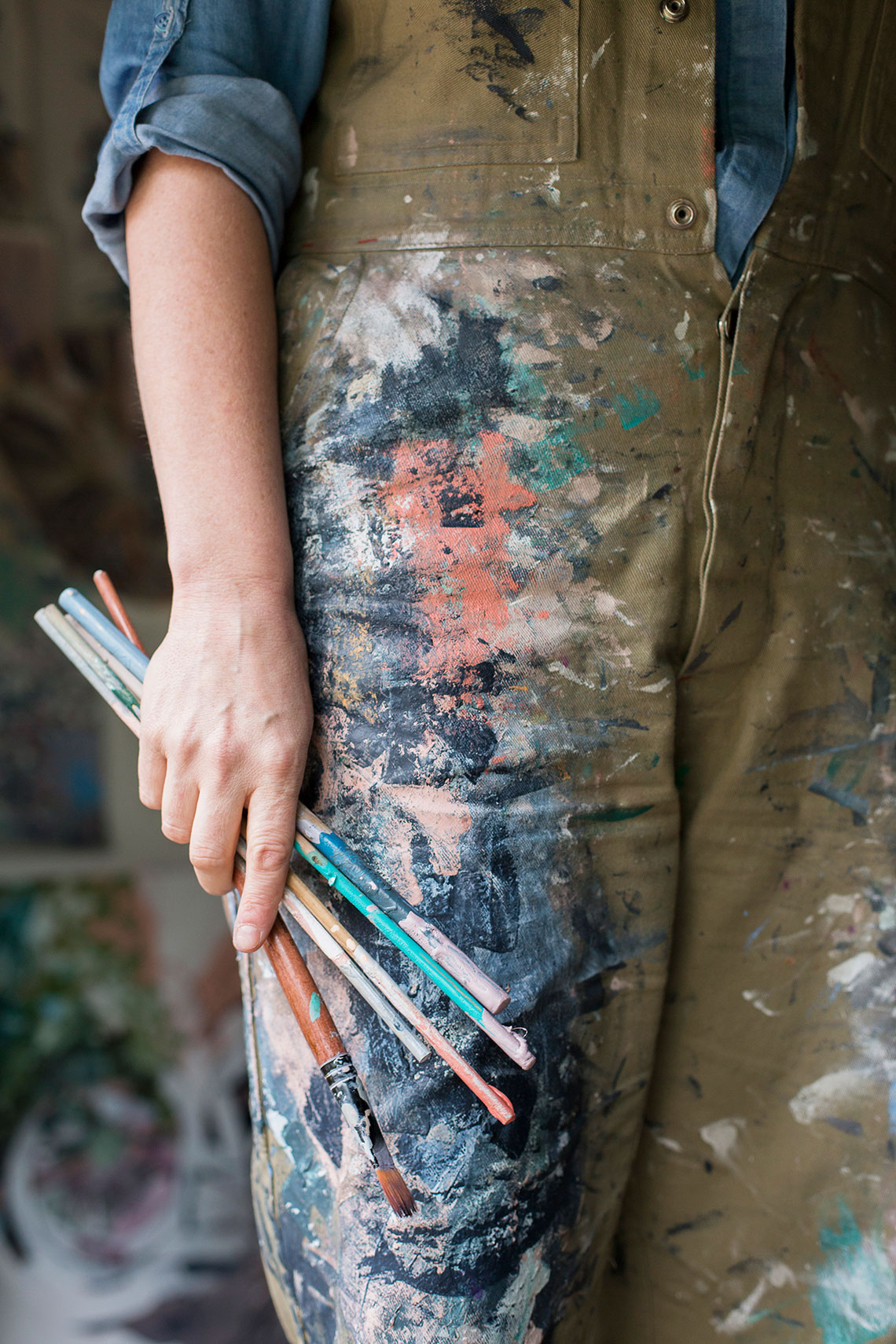
What do you love most about painting?
I love how you can create an instant texture with painting. Depending on what tools you’re using you can get a completely different effect using the same paint or using oil paint, if you apply it with a different tool, then you’re going to get a very different effect. I like the way that I can translate an idea. Instead of just representing a flower as a flower, I can break it down into the way that I see it and represent the details that often people don’t even see. It just becomes part and parcel that people don’t see all those little details.
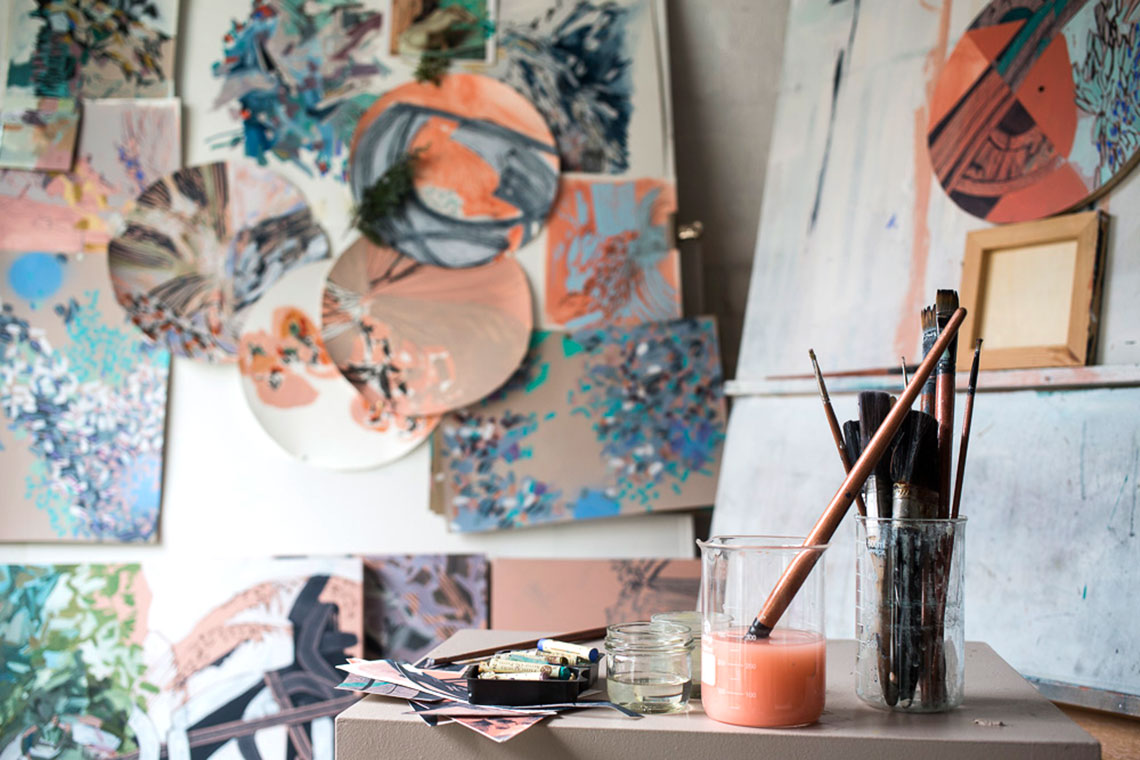
What’s the most important part of your creative process?
The most important part of the creative process for me is being able to make mistakes at the beginning. I work very quickly and I will generally work on three or four paintings at once, especially to start with. Often how they start is not how they end, but I need to be able to have the flow between more than one work so that I don’t get too bogged down in concentrating on one particular painting. It keeps the whole process free.
That’s a really good idea!
It’s fun, and you make a mess, too. It’s really good. Plus you don’t waste paint. Cost-effective paint.
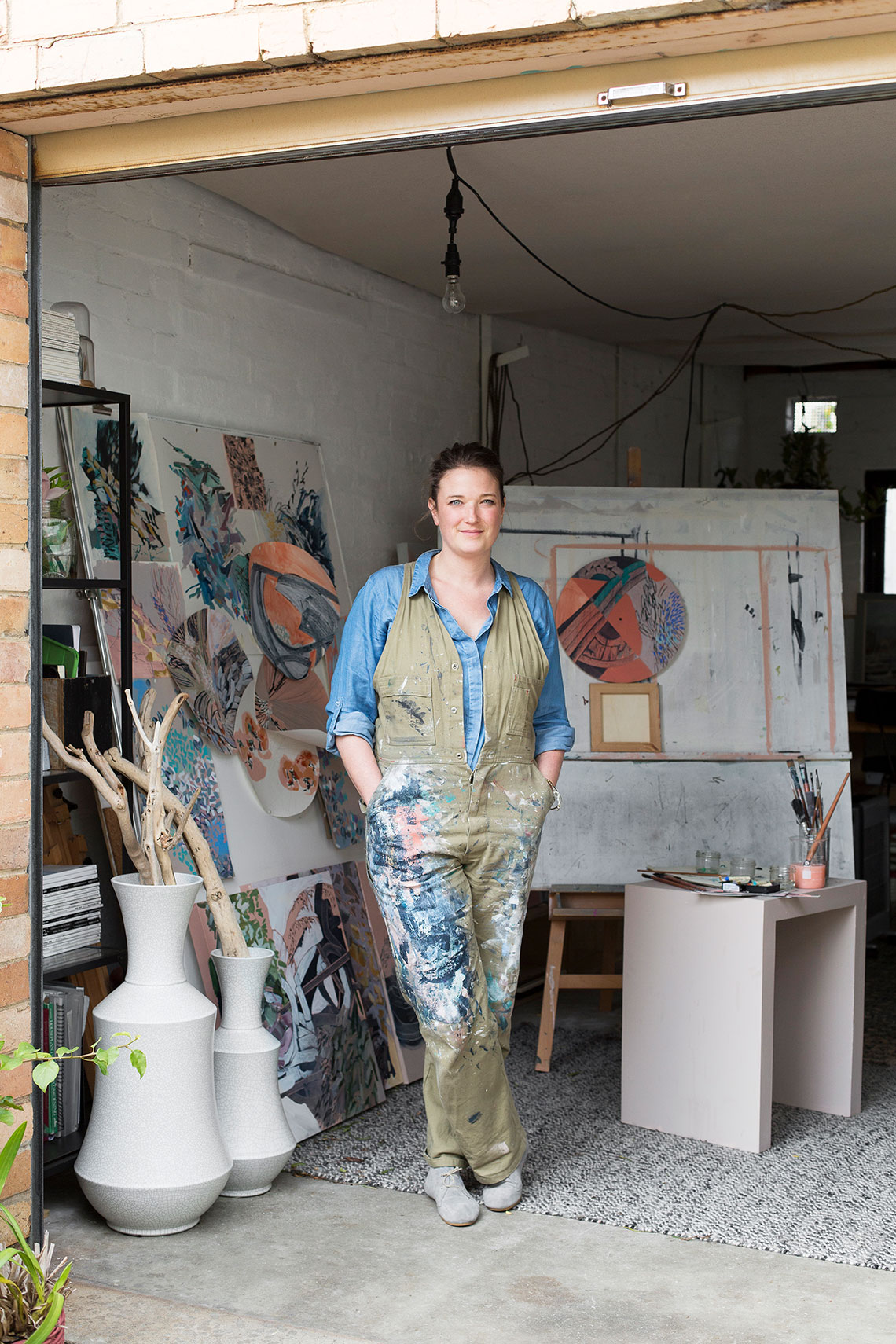
What is something that not many people know about you?
That’s a really hard question because I talk too much. I tell everybody everything. One thing though. When I was a baby, I lived in South Africa. A lot of people don’t know that.
Where were you born?
I was born in Australia, but I’ve lived part of my life in England, as well.
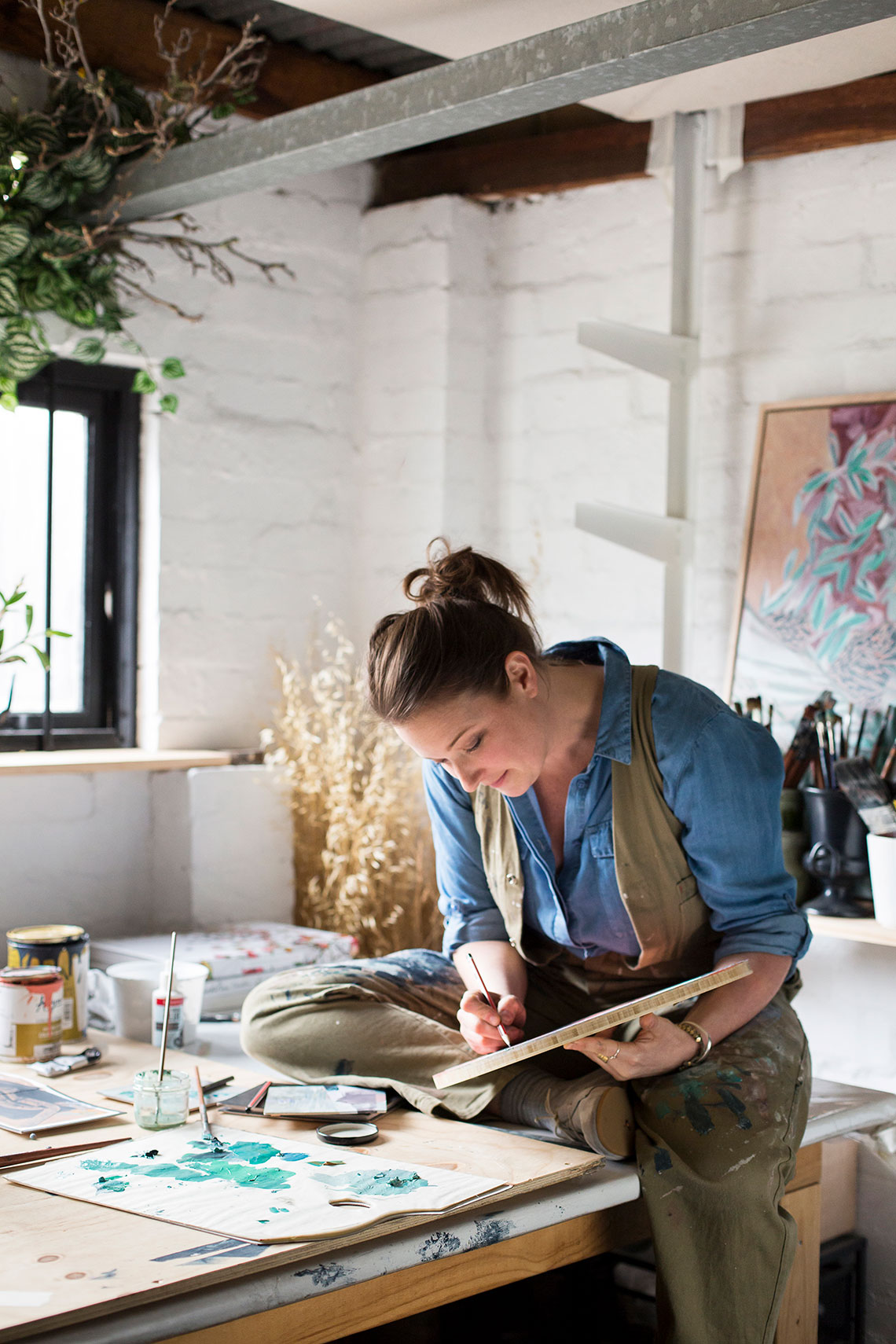
Did you have creative support from your family?
I was lucky that I had a mum who was very supportive of my creative pursuits whereas my father, who was let’s say a more practical person, only really in the last year or so has more respect around what I actually do. That has shaped my process and how I actually got back into painting. I have always had small businesses because I was always like, “Well, I need to make money from my art. I’m not going to be one of those people who can’t.” Dad has pushed me in that way. He was never like, “There you go, there’s your pencils, off you go, be creative.” He always questioned, “How you going to pay your rent?”
You can still be creative and make a living. However some artists find it hard to make money from art…
Well it can be very confronting, because the commodity that you’re selling is yourself. For a lot artists it’s hard if you don’t want to put yourself out there. That’s something that I have had to learn by having my other small businesses. Wedding floristry was really good because it was a product that I was selling. I was the most important aspect of it, because without me there would be no output. But it didn’t feel like I was selling me, I was selling a brand. Even through my textile work, I had a brand name rather than my own name. It’s been a slow progression for me to get to a point where I’m ready to go, “Okay, I’m going to put my name out there and see whether people like my work.” I think that’s probably the most confronting thing for artists because you need to put yourself out there to be able to make an income.
You can’t hide away in your garage…
No, exactly. Your painting only has a monetary value by some of the people who are actually going to buy it. It’s only worth what somebody will spend on it. That’s what I find really challenging about the fine art side of the world. It’s daunting.
Why did you say yes to this collaboration?
Because I love working with people and working with different brands. As well and sort of trying to get into the head of a different brand. Not necessarily just producing something that I want just on a whim, but more so something that’s got a bit of a design parameter to it.
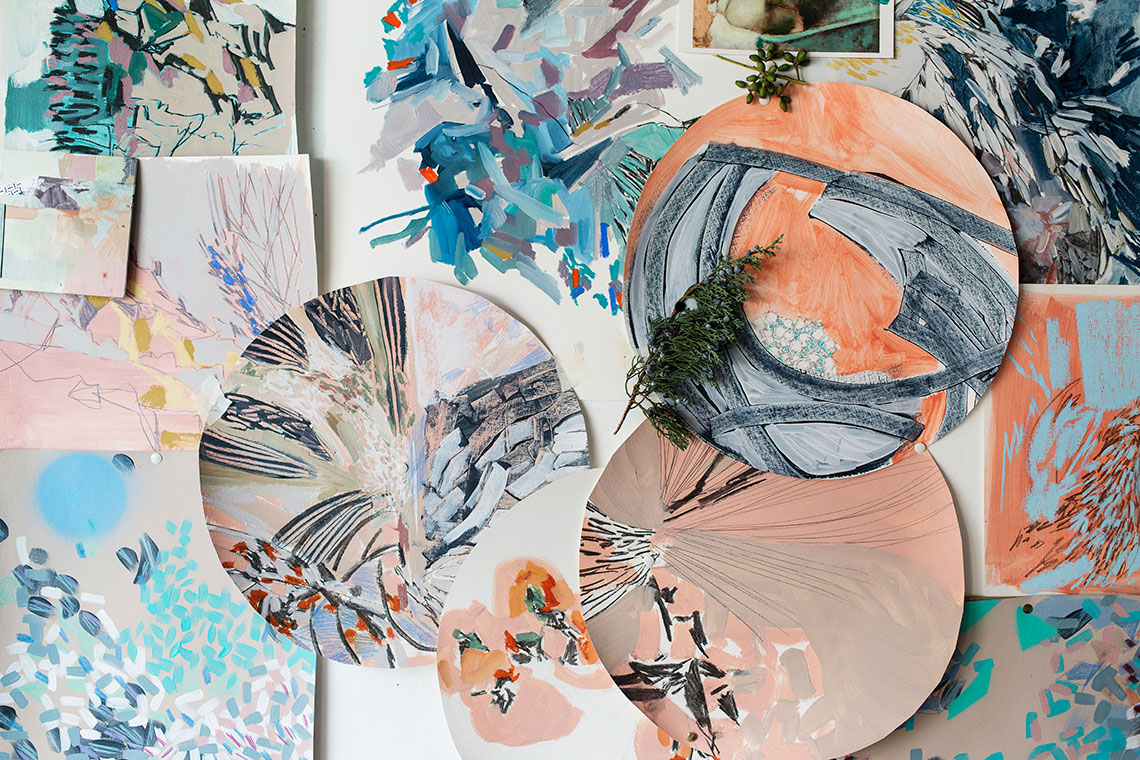
What was your inspiration behind your clock?
For my clock, I was inspired initially by forget-me-nots. It was initially a botanical piece. Then, just organically, it seems to have merged into sundials. I don’t quite know where that’s come from, but in terms of the idea of time, I thought that actually works really nicely with the idea of capturing time through light and shade. That’s what I’ve represented in my clock design.
Can you explain your creative process on the clock so far?
The process that I’ve used so far is very mixed media. I’ve got a bit of collage going on there using a mix of water-based paint, oil paint, charcoal. All my work generally is very layered. I like using different mediums because they all give different effects.
Can you describe the type of person that will be drawn to your clock?
I hope the person that gets my clock is somebody that is interested in botanicals, likes abstracts, and likes colour. Hopefully they’ll make their own interpretation of what the clock is and what it means to them.
Where do you think this clock belongs?
I can see it in a sun room. Somewhere where the light shifts across it, because I often find that a lot of my paintings, they change based on what time of day it is and what kind of light is hitting them.
Amy Wright’s Clock for the Hunting Collective 2016.
Amy’s clock is made with oil pastel, oils, pencil, acrylic and paper collage. Amy’s clock is available via online auction. To bid, click here. Amy Wright is an artist based in Melbourne, Victoria. Amy’s clock has a botanical twist, inspired by shifting light from a sundial.
All photography by Martina Gemmola for Hunting for George



